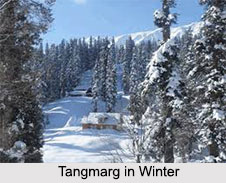 Tangmarg is a town and tehsil in Baramulla district in Indian administered state of Jammu and Kashmir. In 2014 Tangmarg was granted a sub division and trifurcated into 3 Tehsis, with Sub Divisional Magistrate SDM Office located at Tangmarg. The Tangmarg town is central to more than 100 villages in the vicinity. Tangmarg has a post office that has been recently modernised, computerised and renovated and there are plans to develop it into a model post office at par with project arrow post offices. There are many hotels and restaurants, everything required by tourists.
Tangmarg is a town and tehsil in Baramulla district in Indian administered state of Jammu and Kashmir. In 2014 Tangmarg was granted a sub division and trifurcated into 3 Tehsis, with Sub Divisional Magistrate SDM Office located at Tangmarg. The Tangmarg town is central to more than 100 villages in the vicinity. Tangmarg has a post office that has been recently modernised, computerised and renovated and there are plans to develop it into a model post office at par with project arrow post offices. There are many hotels and restaurants, everything required by tourists.
Location of Tangmarg
Tangmarg is 39 km (24 mi) from Srinagar in Srinagar District of Jammu and Kashmir, by a two-lane road.
History of Tangmarg
The history of Tangmarg dates back to Mughal Era. It was used as a gateway to Gulmarg. Literally from local dialect Tang means Pear and Marg means place. There are many pear trees in the vicinity of Tangmarg town scattered in different village.
Culture of Tangmarg
Kashmiri language is the predominant language spoken in the villages of Tangmarg. Urdu is second widely spoken language after Kashmiri. Pahari language is another important language spoken in area whereas English language is also spoken by educated class and those who deal with the tourism industry. Gojri also has many speakers.
Geography of Tangmarg
Tangmarg is located about 39 km (24 mi) from Srinagar. The general approach to the town is through road transport (taxi and bus). Transport is available from Srinagar, Baramulla, Magam, Sopore, Gulmarg and Pattan.
Tourism in Tangmarg
Tangmarg has many tourist spots like Drung, Gulmarg, Baderkoot, Zandpal, Gogaldara, Nigli Nullah and Baba Reshi. The name "Baba Reshi" is locally given to the great Sufi saint of Kashmir Baba Payam ud Din Reshi (RA)` who has a shrine located around 6 km from Tangmarg.
Villages in Tangmarg
Amongst the prominent villages of this tehsils are Hardushoora, Ferozpora, Hardu Ichloo, Khaipora, Kunzer, Kralweth Lalpora, Devpora Dardpora,Ganibaba,Baderkoot, Ratnipora, Karahama,Hardu-Aboora, Hariwatno, Treran, Chandilora,Qazipora. Tangmarg is famous for fresh cold water, heavy snowfall, and tourism. Tangmarg is a hilly area with most parts covered by lush green forests.
Visiting Information
Tangmarg is a major stop for buses and other heavy vehicles between Srinagar and Gulmarg or Babareshi. All the vehicles are allowed beyond this point to Gulmarg which is 13 km. Heavy vehicles are not allowed beyond this point during the winter whenever there is a heavy snowfall. This stop is to be taken seriously since there are no more stores on the way to Gulmarg from Tangmarg. A road from Tangmarg to Gogaldara is under construction.
Related Articles
Cities of Jammu and Kashmir
Culture of Jammu and Kashmir
Jammu and Kashmir
Costumes of Jammu and Kashmir
Baramulla District
Jammu, Jammu & Kashmir



















